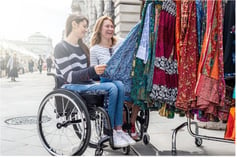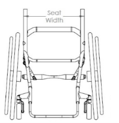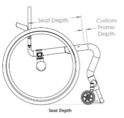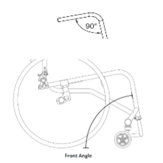 When it comes to manual wheelchairs, one size does NOT fit all. In addition to all the possible configurations and customisations, some manufacturers have unique differences in how their chair is measured, and therefore how it ultimately fits. This can be confusing for the therapist when working with different types and models for chairs, so we thought it would be beneficial to talk through some of the most common differences between custom manual wheelchairs.
When it comes to manual wheelchairs, one size does NOT fit all. In addition to all the possible configurations and customisations, some manufacturers have unique differences in how their chair is measured, and therefore how it ultimately fits. This can be confusing for the therapist when working with different types and models for chairs, so we thought it would be beneficial to talk through some of the most common differences between custom manual wheelchairs.It is firstly important to acknowledge that there is a difference between measurements of a manual wheelchair (MWC) and anthropometric measurements. These differences also highlight the value of an experienced rep who can translate your provided user’s anthropometric measurements or clinical requests (such as a 3° more open backrest angle) into the script (which could be 93° or 87°, or completely different if measured to the seat frame!). Whilst it is beneficial to work closely with your preferred dealer(s), there is also much value in understanding this a little more yourself. Being aware of these small differences will provide additional confidence as the final specifications are selected for your user’s chair, and may even prevent an unwanted scripting error.
What unit of measurement is used
This is such a distinct variation however it might even pass your notice – is the chair measured in inches or centimetres? This will often come down to where the make is based and whether that country uses the imperial or a metric system. You may have come across this without even realising if you measured a chair you thought was a certain size, but the measurements seemed slightly out. For example, TiLite chairs are measured in inches, whereas Progeo are measured in centimetres. A 16” width TiLite would convert to 40.64cms, however a Progeo may offer comparable widths of 36cm or 42cm. This is relevant to know as the size you expected might be a little more, or less, than you originally anticipated! Such considerations also extend to the seating selected; is thar imperial or metric? Prescribing a cushion that has a rigid base or rigidiser measured imperially into a chair that is metric may result in a cushion or backrest that does not fit as anticipated.
What are the non-negotiables
Knowing any non-negotiables can also direct you towards, or away, from particular models. This may be due to engineering barriers of the desired changes, such as large castors potentially fouling in a tight front hanger angle, seat depth impacting arm support options available or maximum rear wheel size. Alternatively, it could be due to the innate designed of that model which may not perhaps offer an adjustable COG or a folding backrest, for example.
Consider writing out the key priorities identified in your initial assessments so that these can be discussed with your experienced local dealer or manufacturer. They can then assist in guiding what make and models offer those priorities, and reduce time trialling options which are already known to not meet the user’s needs.
Some options which may not be available on some models:
- Fold-down backrest
- Flip-up footplate
- Removable sideguards
- Adjustable COG
- Push-to-lock wheellocks
- Spacers
- Ergonomic seat
- Height-adjustable footplate
- Incompatibility with mounting hardware
- Incompatibility with PAD in the future
- Not compatible with some SWLs and anthropometric measurements
Frame measurement tips
 Now we will look a little closer to some nuanced variations which may exist between how MWC measurements are determined across manufacturers.
Now we will look a little closer to some nuanced variations which may exist between how MWC measurements are determined across manufacturers.
- Seat width: Some have this as the internal measurement between back canes, while others have it as the external back canes. Alternatively, it may be the outside of the seat frame rather than back canes. The true seat width is then impacted by the difference between the seat frame to the side guards (or inside of the rear wheels). and
- Overall width: The seat width is less than the overall width of the chair, impacted by the handrim width, tab length selected, spacers if used, and camber. The overall width with 0° camber can be requested or determined which may be beneficial when selecting a seat width if overall width is a concern for access needs.
- Seat depth: This is typically measured from the front of the seat upholstery to the front of the back canes, however on some it may be from the front of the seat upholstery to 0.5-1.5” in front of the back canes. The true seat depth is then impacted by the measurement in relation to the back canes and how the back support/ backrest upholstery interfaces in relation to the back cane position.
 Frame depth: Custom frame depth is the measurement from the end of the seat sling to where the front frame angle begins to bend. This does vary between manufactures, but is often ½ to 1” as standard.
Frame depth: Custom frame depth is the measurement from the end of the seat sling to where the front frame angle begins to bend. This does vary between manufactures, but is often ½ to 1” as standard.
Some models offer an extension as a customisation, which may assist with stability and/or grip for transfers, but may also have limitations depending on the scripted seat depth.
- Seat slope: This is the difference in height measured between the front and rear seat-to-floor height, and is commonly determined by those set heights. However, it is worth noting that the actual angle of seat slope will vary depending on the frame depth, even if the measurement is the same. For example, the amount of slope a 2inch seat slope creates for a 20-inch-deep frame will be less than a 2” seat slope for a 13-inch-deep frame.
There are some models where the seat slope angle itself is set, ensuring that the desired angle will be consistent irrelevant of the seat depth. In these models, the more critical measurement in either the front or rear seat-to-floor height will be selected, and the other determined in relation to the seat slope angle selected.  Front frame angle: Some models may not allow the selection of an angle or offer alternate options, but is worth asking what is standard in these instances. The front frame angle may be measured at the frame bend or in relation to the ground. If it is in relation to the ground, it is important to note whether it is the angle from the back of the front hanger to the ground towards the chair, or from the front of the hanger to the ground in front of the chair. This may mean that 85 and 95 degrees could be the same hanger angle on different chairs, so is worth clarifying whether it is desired to be tighter or more open than 90°, for instance.
Front frame angle: Some models may not allow the selection of an angle or offer alternate options, but is worth asking what is standard in these instances. The front frame angle may be measured at the frame bend or in relation to the ground. If it is in relation to the ground, it is important to note whether it is the angle from the back of the front hanger to the ground towards the chair, or from the front of the hanger to the ground in front of the chair. This may mean that 85 and 95 degrees could be the same hanger angle on different chairs, so is worth clarifying whether it is desired to be tighter or more open than 90°, for instance.- Ergonomic seat: The actual angle of the seat slope will be determined by how the seat slope is typically measured, but will commence from the scripted commencement point on the frame resulting in a more aggressive angle than without an ergonomic seat.
 Front STF height; Typically measured from the front of seat upholstery to the ground. It is worth being aware of this particularly when a custom frame extension is requested as the frame will extend above this height.
Front STF height; Typically measured from the front of seat upholstery to the ground. It is worth being aware of this particularly when a custom frame extension is requested as the frame will extend above this height.- COG: The centre of gravity may be measured from the centre of the rear axle to either in front or the centre of the back canes.
- Backrest angle: The angle may be measured in relation to ground or to the seat. If it is to the seat, the seat slope should be taken into consideration. There are also variations to the direction that ‘plus’ or ‘minus’ is determined, so it may be beneficial to specify whether a more open or closed backrest angle is desired.
 Footplate distance; This is typically measured from the front of the seat upholstery to either the back or front of the footplate. The image however shows the possible implications of this discrepancy; being either too short or long if the incorrect option was provided to how it should be measured.
Footplate distance; This is typically measured from the front of the seat upholstery to either the back or front of the footplate. The image however shows the possible implications of this discrepancy; being either too short or long if the incorrect option was provided to how it should be measured.- Front end adjustments: When tapering is requested, this may be measured from internal or external of the frame tubing. If external, be mindful that tubing width does vary between models, so should be incorporated into the desired footplate width. This may be measured or may be in degrees. V-front can be more challenging to adjust footplate height due to the design.
We hope that thinking through these differences and working closely with your reps will reduce any future unexpected scripting issues. Our team also offers a pathways course which looks at manual wheelchairs in detail, please reach out if this or any other support would be beneficial.
Author

Roseanna Tegel, BHthSc/ MOT
Clinical Services Specialist
Roseanna Tegel joined Permobil in May 2023 as a Clinical Services Specialist. She graduated from Western Sydney University in 2016 with a Bachelor of Health Science/Master of Occupational Therapy and received the Prize in Undergraduate Occupational Therapy for Overall Achievement and the Cerebral Palsy Alliance scholarship. Roseanna began working at residential aged care facilities where her understanding of the need for suitable, person-centred equipment commenced. From there, she transitioned to work in community disability and quickly developed an interest for complex seating and mobility outcomes to benefit both the end user and wider network. She then stepped into a Team Leader role due to her passion for learning and best practice; supporting the Occupational Therapists with their own clinical needs and outcomes, and progressed to also provide external supervision to Occupational Therapists. Roseanna is motivated to support clinicians with their confidence and clinical reasoning allowing them to provide the best outcome for each individual user. Outside of work, Roseanna enjoys time with her dog, playing the 'cello, horse riding and aerial sports.
